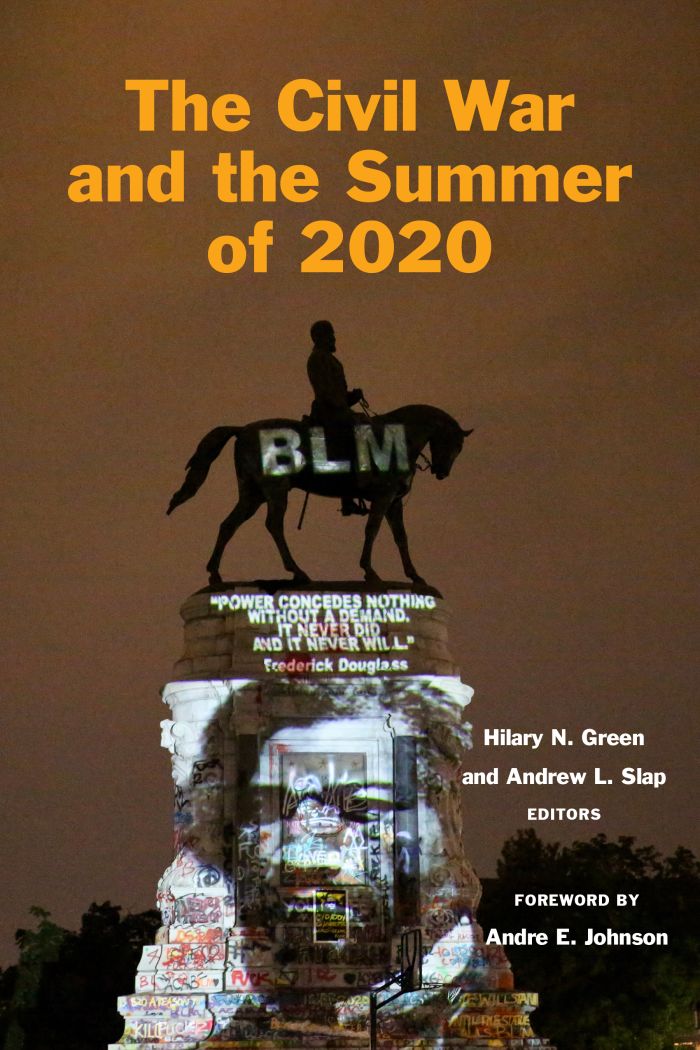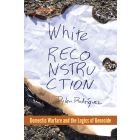The Civil War and the Summer of 2020

This book can be opened with

Investigates how Americans have remembered violence and resistance since the Civil War, including Confederate monuments, historical markers, college classrooms, and history books.
George Floyd’s murder in the summer of 2020 sparked a national reckoning for the United States that had been 400 years in the making. Millions of Americans took to the streets to protest both the murder and the centuries of systemic racism that already existed among European colonists but transformed with the arrival of the first enslaved African Americans in 1619. The violence needed to enforce that systemic racism for all those years, from the slave driver’s whip to state-sponsored police brutality, attracted the immediate attention of the protesters. The resistance of the protesters echoed generations of African Americans’ resisting the violence and oppression of white supremacy. Their opposition to violence soon spread to other aspects of systemic racism, including a cultural hegemony built on and reinforcing white supremacy. At the heart of this white supremacist culture is the memory of the Civil War era, when in 1861 8 million white Americans revolted against their country to try to safeguard the enslavement of 4 million African Americans.
The volume has three interconnected sections that build on one another. The first section, “Violence,” explores systemic racism in the Civil War era and now with essays on slavery, policing, and slave patrols. The second section, titled “Resistance,” shows how African Americans resisted violence for the past two centuries, with essays discussing matters including self-emancipation and African American soldiers. The final section, “Memory,” investigates how Americans have remembered this violence and resistance since the Civil War, including Confederate monuments and historical markers.
This volume is intended for nonhistorians interested in showing the intertwined and longstanding connections between systemic racism, violence, resistance, and the memory of the Civil War era in the United States that finally exploded in the summer of 2020.
Hilary Green and Andy Slap, two extraordinary scholars of the Civil War era, have gathered a diverse group of historians to illuminate anti-Black racism in the past and present. The Civil War and the Summer of 2020 offers a mix of well-established and up-and-coming experts who detail topics that are both familiar and unknown—policing, monuments, sports, religion, resistance, and the Civil War’s impact on Australia and its Indigenous peoples. This collection of impressive essays takes a much-needed communal approach by having scholars lead history-curious readers back in time to understand the present. This book is essential reading for anyone who understands the importance of a more accurate, complex, and engaging understanding of history as a resource for building a more just world.—Kidada E. Williams, author of I Saw Death Coming: A History of Terror and Survival in the War against Reconstruction, and host of the Seizing Freedom podcast.
Those who are interested in more current affairs connections to Civil War memory and the conflict’s present social and political relevance will want to read this book.—Emerging Civil War
Hilary N. Green is James B. Duke Professor of Africana Studies, Africana Studies Department, Davidson College. She is the author of Educational Reconstruction: African American Schools in the Urban South, 1865–1890 (New York: Fordham University Press, 2016), as well as numerous essays and articles. She is currently at work on two projects: a book manuscript examining how everyday African Americans remembered and commemorated the Civil War, and a digital humanities project on Black Civil War memory.
Andrew L. Slap (Edited By)
Andrew L. Slap is a Professor of history at East Tennessee State University. He is the author of The Doom of Reconstruction: The Liberal Republicans in the Civil War Era (Fordham). He is also the editor or co-editor of three volumes on the Civil War era. His current book project is “African American Communities during Slavery, War, and Peace: Memphis in the Nineteenth Century.”
Andre E. Johnson (Foreword By)
Andre E. Johnson is a professor of Communication Studies at the University of Memphis. He is the author of three national award-winning books, The Forgotten Prophet: Bishop Henry McNeal Turner and the African American Prophetic Tradition (2012), The Struggle Over Black Lives Matter and All Lives Matter (with Amanda Nell Edgar, Ph.D., 2018), and No Future in This Country: The Prophetic Pessimism of Bishop Henry McNeal Turner (2020). He is also the editor of the forthcoming Speeches of Bishop Henry McNeal Turner: The Press, the Platform, and the Pulpit (2023) and Preaching During a Pandemic: The Rhetoric of the Black Preaching Tradition (with Kimberly P. Johnson, Ph.D., and Wallis C. Baxter IV, Ph.D., 2023).
Foreword: Telling the Story: George Floyd and the Legacy of Black Truth
Andre E. Johnson | xiii
Preface | xxi
Introduction
Hilary N. Green | 1
Violence
1 White Supremacy, the American Militia, and the Legacy of the Civil War Era
Barbara A. Gannon | 13
2 African Americans and Native Americans in North Carolina During the Summer of 2020:
The Struggle for People of Color to Find a Shared Civil War–Era Memory
Jaime Amanda Martinez | 20
3 Witnessing Ned Scott’s Coffin: Spectacular Police Violence in the Age of Emancipation
John Bardes | 28
4 Abaline Miller and the Struggle for Justice against the Employer Police State after Slavery
William Horne | 38
Resistance
5 From Eagle Buttons to Face Masks: The Dangers of Expressing Racial Equality
Emmanuel Dabney | 49
6 “Give Me My Rights”: Patriotism and Protest Among Black Civil War
Soldiers and Black Lives Matter Activists
Jonathan Lande | 57
7 A Lens Through Which We Can View Society: Sports and Race in America
Daryl A. Carter | 66
8 Slave Agency, the Emancipation Monument, and History’s Reckoning
Karen Cook Bell | 74
9 Fighting for Black Humanity: Political Action of Post-Emancipation Black Christians
Nicole Myers Turner | 81
10 Jim Crow Then, Jim Crow Now: Police Violence, Tort Law, and Black
Resistance in the Twentieth and Twenty-First Centuries
Myisha S. Eatmon | 90
11 “How wonderful a country”: Black Lives Matter and the Long History of Aboriginal Resistance
Samuel Watts | 97
Memory
12 Carpetbagging the Colfax Riot Marker
LeeAnna Keith | 107
13 “Moving History”: The Life and Afterlife of Louisville’s Confederate Monument
Anne E. Marshall | 113
14 Goodbye, Calhoun. What’s Next?: The Future of Charleston’s Commemorative Landscape
Adam H. Domby | 122
15 “Back at Bragg”: Civil War Memory and the US Army
Beau Cleland | 131
16 There’s still no balm in Gilead: The Fatal Costs of Traumatic Memory
Scott Hancock | 140
Acknowledgments | 151
List of Contributors | 153
Index | 157




